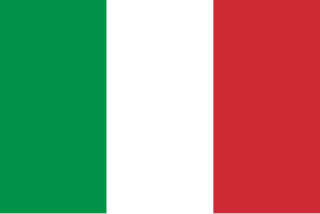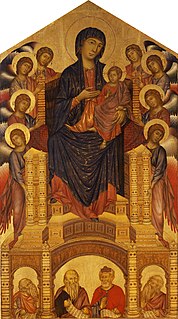
Cimabue, also known as Cenni di Pepo or Cenni di Pepi, was an Italian painter and designer of mosaics from Florence.

A crucifix is an image of Jesus on the cross, as distinct from a bare cross. The representation of Jesus himself on the cross is referred to in English as the corpus.

Saint Francis of Assisi, born Giovanni di Pietro di Bernardone, informally named as Francesco, was an Italian Catholic friar, deacon and preacher. He founded the men's Order of Friars Minor, the women's Order of Saint Clare, the Third Order of Saint Francis and the Custody of the Holy Land. Francis is one of the most venerated religious figures in history.

Assisi is a town and comune of Italy in the Province of Perugia in the Umbria region, on the western flank of Monte Subasio.

Assisi embroidery is a form of counted-thread embroidery based on an ancient Italian needlework tradition in which the background is filled with embroidery stitches and the main motifs are outlined but not stitched. The name is derived from the Italian town of Assisi where the modern form of the craft originated.

Giunta Pisano was an Italian painter. He is the earliest Italian painter whose name is found inscribed on an extant work. He is best known for his crucifixes.

Saint Lawrence of Brindisi, O.F.M. Cap., born Giulio Cesare Russo, was a Roman Catholic priest and a theologian as well as a member of the Order of Friars Minor Capuchin.

The Cathedral Basilica of Saint Francis of Assisi, commonly known as Saint Francis Cathedral, is a Roman Catholic cathedral in downtown Santa Fe, New Mexico. It is the mother church of the Archdiocese of Santa Fe.

The Basilica of Saint Mary of the Angels is a Papal minor basilica situated in the plain at the foot of the hill of Assisi, Italy, in the frazione of Santa Maria degli Angeli.
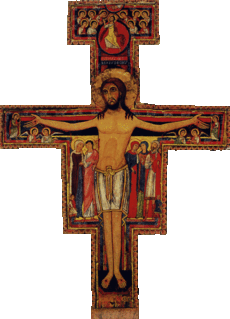
The San Damiano Cross is the large Romanesque rood cross before which St. Francis of Assisi was praying when he is said to have received the commission from the Lord to rebuild the Church. It now hangs in the Basilica of Saint Clare in Assisi, Italy, with a replica in its original position in the church of San Damiano nearby. Franciscans cherish this cross as the symbol of their mission from God. The cross is a crucifix of a type sometimes called an icon cross because in addition to the main figure of the Christ, it contains images of other saints and people related to the incident of Christ's crucifixion. The tradition of such painted crucifixes began in the Eastern Church and possibly reached Italy via Montenegro and Croatia.

The Master of Saint Francis was an anonymous Italian painter, perhaps of Pisan origin though probably trained in Umbria, working between 1250–1280. His work embodies an important aspect of the contact between Italian and Byzantine art of this period.
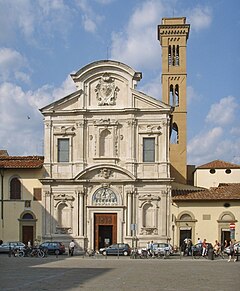
The chiesa di San Salvatore di Ognissanti or more simply chiesa di Ognissanti, is a Franciscan church located on the piazza of the same name in central Florence, region of Tuscany, Italy. Founded by the lay order of the Umiliati, the church was dedicated to all the saints and martyrs, known and unknown.

San Damiano is a church with a monastery near Assisi, Italy. Built in the 12th century, it was the first monastery of the Order of Saint Clare, where Saint Clare built her community.
The Expressionist Master of Santa Chiara was an Umbrian painter active between about 1290 and around 1330. He has been identified as one of Giotto's principal followers; some contend that his hand may be identified in a series of frescos attributed to Giotto in the Basilica of San Francesco d'Assisi. Among the surviving works attributed to him are a set of processional crucifixes, including one in the Cleveland Museum of Art.
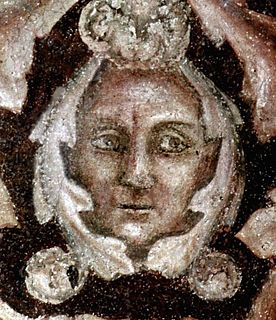
Giotto di Bondone, known mononymously as Giotto and Latinised as Giottus, was an Italian painter and architect from Florence during the Late Middle Ages. He worked during the Gothic/Proto-Renaissance period.

The Crucifix by Cimabue at Santa Croce is a wooden crucifix, painted in distemper, attributed to the Florentine painter and mosaicist Cimabue, one of two large crucifixes attributed to him. The work was commissioned by the Franciscan friars of Santa Croce and is built from a complex arrangement of five main and eight ancillary timber boards. It is one of the first Italian artworks to break from the late medieval Byzantine style and is renowned for its technical innovations and humanistic iconography.

The Abbey of St. Peter in Assisi, Italy, is inhabited by a small community of monks belonging to the Benedictine Cassinese Congregation. They live according to the Rule of St. Benedict, summarized as "Ora et Labora".
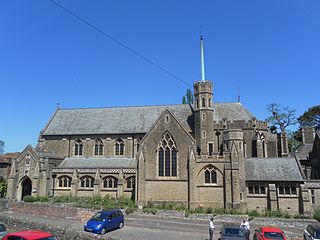
Sacred Heart Church is a Roman Catholic Parish church in Petworth, West Sussex, England. It was built in 1896 and designed by Frederick Walters. It is situated on Angel Street to the north of Petworth Cottage Museum in the centre of the town. It is a Gothic Revival church and a Grade II listed building.
The Master of the Franciscan Crucifixes is the notname given to an Italian painter active in the 1260s and 1270s. The notname is based on a painted crucifix now in the Basilica of San Francesco d'Assisi, which was found to be connected stylistically with two painted crucifixes in Bologna and fragments of two paintings in the National Gallery of Art in Washington, D.C. The artist is presumed to have been Umbrian by origin and training.
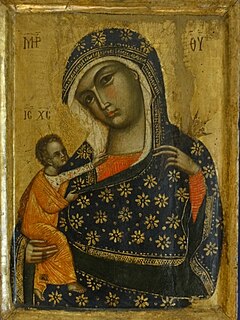
The Treasure museum of the basilica of Saint Francis contains a collection of sacred art that is on display in two halls found on the northern side of the Cloister of Pope Sixtus IV which is part of the Sacro Convento in Assisi, Italy. The entrance is found on the second level of the renaissance cloister behind the apse of the Basilica of Saint Francis, which houses the remains of St. Francis of Assisi. Since 1986 the Museum has also displayed a collection of works donated to the Conventual Franciscan Friars by the Secular Franciscan and American art critic, Frederick Mason Perkins, who died in Assisi in October 1955.

